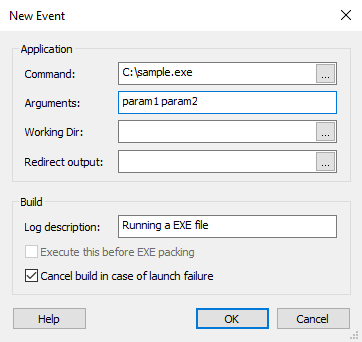
How to Incorporate an Exe File Into Your Personalized Events Setup

How to Incorporate an Exe File Into Your Personalized Events Setup
Table of Contents
- Introduction
- Registration
- Using Advanced Installer
- GUI
- Working with Projects
- Installer Project
* Product Information
* Resources
* Package Definition
* Install Parameters
* Organization
* Builds
* Configuration Tab
* Advanced Media Tab
* Mac OS X Tab
* App-V 4.x Tab
* App-V 5.x Tab
* ThinApp Tab
* Configuration Tab
* App Installer Tab
* UWP Bootstrapper Tab
* Build Events Tab
* Edit Event Dialog
* Add a command-line batch file as a custom event
* Add a VBScript file as a custom event
* Add an executable file as a custom event
* Powershell build event
* Optional Package Tab
* Symbol Files Tab
* Analytics
* SCCM
* ActiveSync
* Requirements
* User Interface
* System Changes
* Server
* Custom Behavior - Patch Project
- Merge Module Project
- Updates Configuration Project
- Windows Store App Project
- Modification Package Project
- Optional Package Project
- Windows Mobile CAB Projects
- Visual Studio Extension Project
- Software Installer Wizards - Advanced Installer
- Visual Studio integration
- Alternative to AdminStudio/Wise
- Replace Wise
- Migrating from Visual Studio Installer
- Keyboard Shortcuts
- Shell Integration
- Command Line
- Advanced Installer PowerShell Automation Interfaces
- Features and Functionality
- Tutorials
- Samples
- How-tos
- FAQs
- Windows Installer
- Deployment Technologies
- IT Pro
- MSIX
- Video Tutorials
- Advanced Installer Blog
- Table of Contents
Disclaimer: This post includes affiliate links
If you click on a link and make a purchase, I may receive a commission at no extra cost to you.
Add an executable file as a custom event
Introduction
An EXE file is an executable program you can run in Microsoft Windows. It’s made up of a coded set of instructions that the computer can start right away when the file icon is clicked on.
The binary machine code in the EXE communicates directly with the computer, instructing the central processing unit on how to run a program. The processor then commands the computer’s hardware what to do.
Add an EXE file as an event
It is possible to create an event based on an EXE file you created. Depending on your script, the EXE file can or can not accept command line arguments.

This event is equivalent to running the sample.exe param1 param2 prior or post-build time depending on how you created the event.
In case your script doesn’t require command line arguments leave the “Arguments” field blank.
Did you find this page useful?
Please give it a rating:
Thanks!
Report a problem on this page
Information is incorrect or missing
Information is unclear or confusing
Something else
Can you tell us what’s wrong?
Send message
Also read:
- [Updated] 2024 Approved Capturing Flawless Footage Premium PC/Mac Options Reviewed
- [Updated] In 2024, Transform Your Live Broadcasting Skills Using DSLR on Personal Computers
- 1. Understanding Pre-Set Conditions: A Comprehensive Guide
- 2024 Approved Perfecting Transition Timings in Premiere Audio
- 全サポート動画フォーマットの変換技術&方法:AVCHD、TS、MOV、AVI、WMV、FLV対応コンバータ
- Charming Cyberspace: AI for Romance Fraud
- Effective Techniques for Eliminating Shadows in Photographs
- How to Bypass Android Lock Screen Using Emergency Call On Honor X8b?
- How To Transfer Data From iPhone 12 Pro Max To Other iPhone 13 Pro Max devices? | Dr.fone
- How to Unlock Samsung Galaxy Z Flip 5 Phone without Google Account?
- Leading No-Cost Image Upload & Share Sites
- Simple Steps to Update Your TikTok Avatar: A 2022 Guide
- Top Tools for HD Gaming Video Recording - A Four-Step Guide
- Title: How to Incorporate an Exe File Into Your Personalized Events Setup
- Author: Kenneth
- Created at : 2024-10-08 20:02:44
- Updated at : 2024-10-11 06:17:49
- Link: https://fox-sys.techidaily.com/how-to-incorporate-an-exe-file-into-your-personalized-events-setup/
- License: This work is licensed under CC BY-NC-SA 4.0.